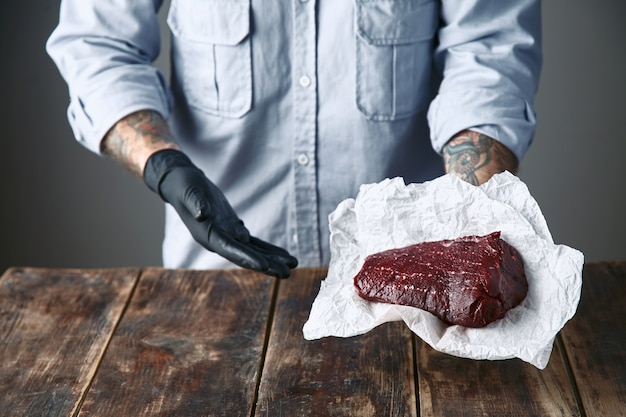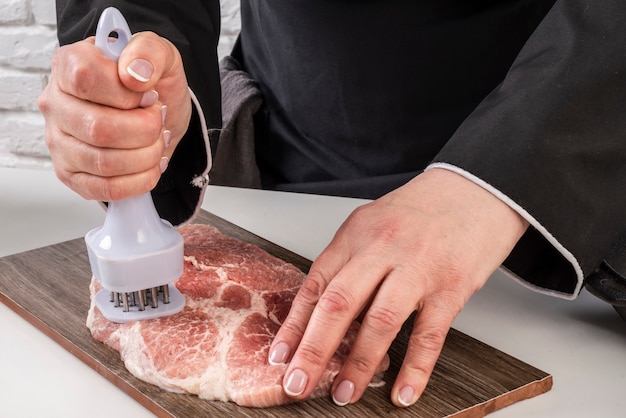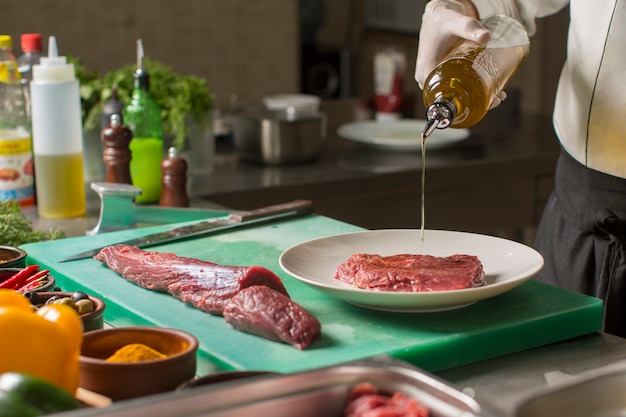Let's face it, there's something undeniably satisfying about a perfectly cooked steak. That beautiful sear, the juicy pink center, the melt-in-your-mouth texture – it's culinary perfection at its finest. But for those of us who aren't seasoned grill masters, the idea of tackling a steak can feel a bit intimidating. Fear not, my fellow steak enthusiasts! I'm here to guide you through the world of steak-slaying, sharing my personal experiences, tips, and tricks along the way. By the end of this guide, you'll be grilling like a seasoned pro, impressing your friends and family with your newfound steak mastery.
(Part 1) choosing the right cut: A Journey Through steak cuts

The steak cuts: A Beginner's Guide to the "Who's Who" of Steak
The first step in your quest for the perfect steak is choosing the right cut. It's like picking the right weapon for a battle – a strategic decision that will significantly impact the outcome. Now, there's a lot of jargon thrown around in the world of steak, which can feel overwhelming to a newbie. But I'm here to simplify things, just like I do when my kids bombard me with questions about what's for dinner. Let's break it down into a few key categories:
The Classics: These are the go-to choices, the crowd-pleasers, the reliable stars of any steak dinner. We're talking ribeye, new york strip, and filet mignon. Each has its own distinct qualities, but you can't go wrong with any of them. I'm a bit of a ribeye fan myself, drawn to its rich marbling and succulent flavour.
The budget-friendly: Not everyone can afford to splurge on a fancy cut, and that's perfectly okay! There are some excellent budget-friendly options that can still deliver incredible flavour. Think flank steak, skirt steak, or even a good old-fashioned chuck roast. These cuts might need a little extra love to tenderize, but trust me, they're absolutely worth the effort. I've created some incredible beef tacos with flank steak, and let me tell you, the flavour is phenomenal.
The Adventure: For the daring palates, those who crave exploration and new flavours, there are some less common cuts that can really surprise you. I'm talking about things like hanger steak, tri-tip, or even a delicious bone-in rib roast. These are all truly worth a try.
Fat, Marbling, and Everything in Between: The Secret to a juicy steak
Now, here's a little secret that seasoned steak chefs know: fat is your friend. It's not just about taste; it's about texture too. A well-marbled steak will be more tender, flavorful, and juicy. Look for those beautiful streaks of white fat running throughout the meat. They're the key to that melt-in-your-mouth experience!
(Part 2) Getting Ready for the Big Day: Preparing Your Steak for Success

Taking it Out of the Fridge: Let Your Steak Breathe
Okay, so you've got your perfect cut of meat. What's next? The key here is to let your steak come to room temperature. Don't even think about cooking it straight from the fridge. It needs to relax, adjust to the room, and get happy. It'll cook more evenly this way, and you'll get a better sear. Just give it a good 30 minutes or so before you start cooking.
Seasoning with a Purpose: The Art of Simplicity
Now, it's time to season your steak. This is where you can really get creative, but I like to keep it simple. Salt and pepper are all you need. If you want to add a touch of garlic or onion powder, go for it, but don't go overboard. The most important thing is to season generously, especially the sides and edges. This will help create a delicious, crispy crust. And be sure to use good quality salt. I've found that a good flaky salt makes all the difference in the final flavour.
Oil Up and Ready to Go: Choosing the Right Lubricant
Before we get to the cooking part, let's talk about oil. You want to choose a neutral oil with a high smoke point, like grapeseed oil or avocado oil. The high smoke point ensures that the oil doesn't burn before the steak reaches the right temperature. And don't forget to coat your pan or grill grates with a thin layer of oil. This will prevent the steak from sticking and ensure a smooth cooking experience.
(Part 3) cooking techniques for steak mastery: Mastering the Heat

The Art of Searing: A Crispy Crust That's Worth the Wait
The sear is the key to a perfect steak. It creates that crispy, flavorful crust that makes your mouth water. It's a crucial part of the process and something you'll get better at with practice, just like learning to ride a bike. The goal is to get the steak nice and hot on the outside without overcooking the inside. Here's how to do it:
Pan-Searing: Get your pan nice and hot, then add the steak. Don't move it around too much; just let it cook for a couple of minutes on each side. This will give you a beautiful, crispy crust. A cast iron pan is great for searing, as it holds heat really well.
Grilling: If you're using a gas grill, heat the grates to high heat. For charcoal, get the coals nice and hot – you know you've got it right when the coals are mostly white. Just like with pan-searing, let the steak cook for a few minutes on each side, and don't be tempted to move it too much.
Flipping the Steak: The "Less is More" Approach
Here's a little tip that separates the steak rookies from the seasoned pros: Don't flip your steak too often. Each time you flip it, you're interrupting the cooking process. You want to let the steak cook on each side until a nice crust forms.
The Flip-Flop: Mastering the Grill Marks for a Visual Feast
Once you've flipped your steak a few times, you're ready for the fun part. The flip-flop technique is how you get those beautiful, iconic grill marks. It's simple, really: rotate your steak 90 degrees after each flip. You'll end up with those perfect criss-cross patterns, which look amazing on a plate and tell everyone you know what you're doing.
(Part 4) The Rest Is Just a Matter of Time: Letting Your Steak Relax
Don't Overdo It: Finding the Perfect Level of Cook
After searing, you'll want to move your steak to a cooler part of the stovetop or grill, or even to a preheated oven. The goal is to cook the steak through to your desired level of doneness without overcooking it.
Reading the Steak's Temperature: Your Inner Chef's Secret Weapon
If you're a serious steak enthusiast, investing in a digital thermometer is a must. It's your secret weapon for ensuring your steak is cooked to perfection. If you don't have one, you can use the finger test. Here's how it works:
Rare: The steak should feel soft and slightly springy, like the tip of your pinky finger.
Medium-Rare: The steak should feel firm but still slightly springy, like the tip of your index finger.
Medium: The steak should feel firm to the touch, like the tip of your middle finger.
Medium-Well: The steak should feel firm and slightly hard, like the tip of your ring finger.
Well-Done: The steak should feel hard to the touch, like the tip of your thumb.
Resting Is Not Optional: A Time for Relaxation
Once your steak is cooked to your liking, it's important to let it rest for at least 5-10 minutes before slicing. This is a crucial step! It allows the juices to redistribute throughout the meat, resulting in a more tender and juicy steak. You can cover it loosely with foil to keep it warm.
(Part 5) steak doneness: A Guide for the Beginner: Finding Your Perfect Level
Finding Your Ideal Doneness: A Matter of Personal Preference
Every steak lover has their own preferred level of doneness. Here's a table to help you visualize the internal temperatures of each level:
| Level of Doneness | Internal Temperature (°F) | Internal Temperature (°C) | Description |
|---|---|---|---|
| Rare | 125-130 | 52-54 | Center will be cool and red. |
| Medium-Rare | 130-135 | 54-57 | Center will be warm and red. |
| Medium | 135-140 | 57-60 | Center will be warm and pink. |
| Medium-Well | 140-145 | 60-63 | Center will be warm and brown. |
| Well-Done | 145-150 | 63-66 | Center will be hot and brown. |
My Personal Preference: Embracing Medium-Rare
I'm a big fan of medium-rare. It's the sweet spot, juicy and tender, with just a hint of pink. But honestly, it all comes down to personal taste. If you're not sure, start with medium-rare and adjust based on your own preferences.
(Part 6) steak sides: Elevating Your Dinner with Complementary Flavors
The Perfect Pairing: Finding the Right side dish for Your Steak
Now that you've got your steak cooked to perfection, it's time to think about sides. The right side dish can really enhance the flavour of your steak, creating a well-balanced meal. Here are a few of my personal favourites:
Roasted Vegetables: Nothing beats a classic. roasted asparagus, Brussels sprouts, or even broccoli are all great options. Try roasting them with some olive oil, salt, pepper, and a little bit of garlic.
potato gratin: This creamy, cheesy potato dish is a classic French side that pairs beautifully with steak. The combination of potatoes, cream, cheese, and nutmeg is simply divine.
Green Salad: A fresh and refreshing salad is a perfect counterpoint to the richness of a steak. Try a simple mix of greens, cherry tomatoes, cucumbers, and a light vinaigrette.
(Part 7) Mastering the steak sauces: The Finishing Touch
The Finishing Touch: Adding a Flavorful Dimension to Your Steak
A good steak sauce can take your meal to the next level. But choose wisely! Avoid the overly sweet, artificial-tasting varieties. I prefer a simple, flavorful sauce that complements the steak, not overpowers it. Here are a few ideas to get you started:
Béarnaise Sauce: This classic French sauce is rich and creamy, with a hint of tang.
Red Wine Sauce: A simple red wine sauce is another classic option. You can make it with red wine, shallots, and a little bit of butter. It adds a lovely depth of flavour to the steak.
Peppercorn Sauce: For a bolder flavour, try a peppercorn sauce. It's made with black peppercorns, brandy, and cream.
(Part 8) steak storage: Keeping it Fresh and Ready to Cook
Storing Your Meat: A Guide to Maximizing Freshness
If you're not planning on cooking your steak right away, make sure you store it properly. Keep it in the fridge, wrapped tightly in plastic wrap or aluminum foil. You can also vacuum-seal it to extend its shelf life.
Freezing Your Steak: For a Future Feast
You can freeze steak for up to 3 months, but it's best to freeze it in portions, like individual steaks. This makes it easier to thaw and cook. To freeze, wrap the steak tightly in plastic wrap, then place it in a freezer-safe bag.
(Part 9) Common Steak Questions Answered: Demystifying the Steak Process
FAQs: A Comprehensive Guide to Your Steak-Related Questions
- What is the best way to thaw frozen steak? The best way to thaw frozen steak is in the refrigerator. It takes about 24 hours to thaw a 1-inch thick steak. You can also thaw it in cold water, but make sure you change the water every 30 minutes.
- How long can I store raw steak in the fridge? Raw steak can be stored in the fridge for 3-5 days. It's important to keep it properly wrapped to prevent spoilage.
- What's the best way to clean a cast iron pan after cooking steak? After you've cooked your steak, let the pan cool down, then scrub it with a stiff brush and hot water. Don't use soap, as this can affect the seasoning of the pan. You can also use a little bit of salt to help remove any stubborn bits of food.
- What should I do if my steak is overcooked? If your steak is overcooked, it's unfortunately a little too late to salvage it. But you can still make it edible by slicing it thin and using it in dishes like tacos or stir-fries.
- Can I cook a steak on a skillet? Absolutely! A skillet is a great option for cooking a steak. Just make sure it's heavy-bottomed and heated to high heat before adding the steak.
So there you have it! You've now got all the knowledge you need to become a steak master. You're ready to take on any challenge, whether it's a fancy dinner party or a simple weeknight meal. Just remember, practice makes perfect, so don't be afraid to experiment and find your own unique steak style. Bon appetit!
Everyone is watching

Prime Rib Roast Cooking Time Chart: Per Pound Guide
Cooking TipsPrime rib roast. Just the name conjures images of lavish dinners, crackling fires, and hearty laughter. It’s ...

How Long to Bake Potatoes in the Oven (Perfect Every Time)
Cooking TipsBaked potatoes are a staple in my kitchen. They're incredibly versatile, delicious, and surprisingly easy to m...

Perfect Rice Every Time: The Ultimate Guide to Cooking Rice
Cooking TipsAs a self-proclaimed foodie, I've always been a bit obsessed with rice. It's the foundation of countless cuisi...

The Ultimate Guide to Cooking Asparagus: Tips, Techniques, and Recipes
Cooking TipsAsparagus. The mere mention of this spring delicacy conjures up images of vibrant green spears, crisp and burs...

Ultimate Guide to Cooking the Perfect Thanksgiving Turkey
Cooking TipsThanksgiving. Just the word conjures up images of overflowing tables laden with delicious food, the scent of r...
